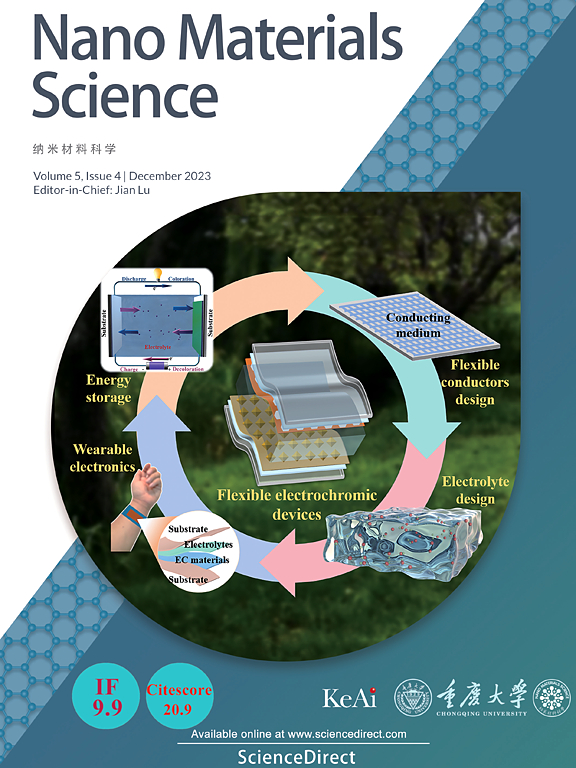Room-temperature fast self-healing graphene polyurethane network with high robustness and ductility through biomimetic interface structures
IF 17.9
2区 材料科学
Q1 Engineering
引用次数: 0
Abstract
Intelligent polymers have garnered significant attention for enhancing component safety, but there are still obstacles to achieving rapid self-healing at room temperature. Here, inspired by the microscopic layered structure of mother-of-pearl, we have developed a biomimetic composite with high strength and self-repairing capabilities, achieved by the ordered arrangement of pearl-like structures within a flexible polyurethane matrix and GO nanosheets functionalized by in situ polymerization of carbon dots (CDs), this biomimetic interface design approach results in a material strength of 8 MPa and toughness (162 MJ m−3), exceptional ductile properties (2697 % elongation at break), and a world-record the fast and high-efficient self-healing ability at room temperature (96 % at 25 °C for 60 min). Thereby these composites overcome the limitations of dynamic composite networks of graphene that struggle to balance repair capability and robustness, and the CDs in situ loaded in the interfacial layer inhibit corrosion and prevent damage to the metal substrate during the repair process. (The Ƶ f=0.01Hz was 1.81 × 109 Ω cm2 after 2 h of healing). Besides, the material can be intelligently actuated and shape memory repaired, which provides reliable protection for developments in smart and flexible devices such as robots and electronic skins.
通过仿生界面结构实现室温快速自愈合石墨烯聚氨酯网络的高鲁棒性和延展性
智能聚合物在提高组件安全性方面获得了极大的关注,但在室温下实现快速自修复仍然存在障碍。在这里,受珍珠母微观层状结构的启发,我们开发了一种具有高强度和自修复能力的仿生复合材料,通过在柔性聚氨酯基体中有序排列珍珠状结构和碳点(cd)原位聚合功能化的氧化石墨烯纳米片,这种仿生界面设计方法使材料强度达到8 MPa,韧性(162 MJ m−3)。优异的延展性(断裂伸长率为2697%),以及在室温下快速高效的自愈能力(25°C, 60分钟,96%),创造了世界纪录。因此,这些复合材料克服了石墨烯动态复合网络难以平衡修复能力和坚固性的局限性,并且在界面层中原位加载的CDs抑制了腐蚀,防止了修复过程中对金属基板的损坏。(愈合2 h后Ƶ f=0.01Hz为1.81 × 109 Ω cm2)。此外,该材料可以智能驱动和形状记忆修复,为机器人和电子皮肤等智能柔性设备的发展提供可靠的保护。
本文章由计算机程序翻译,如有差异,请以英文原文为准。
求助全文
约1分钟内获得全文
求助全文
来源期刊

Nano Materials Science
Engineering-Mechanics of Materials
CiteScore
20.90
自引率
3.00%
发文量
294
审稿时长
9 weeks
期刊介绍:
Nano Materials Science (NMS) is an international and interdisciplinary, open access, scholarly journal. NMS publishes peer-reviewed original articles and reviews on nanoscale material science and nanometer devices, with topics encompassing preparation and processing; high-throughput characterization; material performance evaluation and application of material characteristics such as the microstructure and properties of one-dimensional, two-dimensional, and three-dimensional nanostructured and nanofunctional materials; design, preparation, and processing techniques; and performance evaluation technology and nanometer device applications.
文献相关原料
公司名称
产品信息
阿拉丁
riboflavin sodium phosphate
阿拉丁
N, N-dimethylformamide (DMF)
阿拉丁
dibutyltin dilaurate (DBTDL)
阿拉丁
4,4′-dicyclohexylmethane diisocyanate (HMDI)
阿拉丁
thiourea
阿拉丁
2,6-pyridinedimethanol
 求助内容:
求助内容: 应助结果提醒方式:
应助结果提醒方式:


